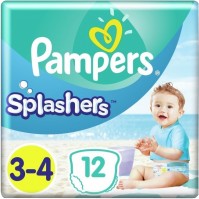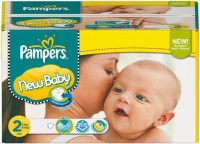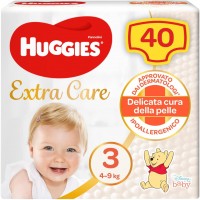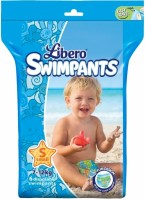Nappies Huggies
All Nappies Advanced filters → |
You might be interested in
Nappies: specifications, types
Suitable for
Age category for which diapers are designed. Both dimensions and some features of the shape depend on this.
Most modern diapers are intended for children — up to a certain age, babies inevitably "dirty diapers", and excesses are possible even at a fairly conscious age. However, the need for diapers can also occur in a teenager, and even in an adult — usually it is due to health problems (night wetting, spinal injurie...s, etc.). Accordingly, models for these age categories are also presented on the market.
Most modern diapers are intended for children — up to a certain age, babies inevitably "dirty diapers", and excesses are possible even at a fairly conscious age. However, the need for diapers can also occur in a teenager, and even in an adult — usually it is due to health problems (night wetting, spinal injurie...s, etc.). Accordingly, models for these age categories are also presented on the market.
Type
— Diapers. In this case, diapers of a classical design are meant — hygienic devices for absorbing moisture (primarily urine) and protecting surrounding objects (outerwear, bedding, etc.) from pollution. Such devices, usually, cover the pelvic region of the child as much as possible, covering not only the groin, but also the abdomen and hips. Compared to panties, classic diapers are more reliable — in particular, because they are able to absorb more liquid; also from their advantages it is worth...noting suitability for all age categories. At the same time, such a diaper can create inconvenience for an older child when moving and wearing clothes.
— Panties. In full accordance with the name, such devices are more like ordinary underpants than diapers. They are designed for older children and are designed for the fact that the child usually moves a lot and actively during the day — panties do not restrict movement as much as classic diapers, and allow you to put on clothes of a regular cut without problems. In addition, these products themselves are more convenient to put on, which can be useful, for example, during a trip. Also, the use of panties can be part of the educational process when teaching a baby to use the toilet; some brands are even positioned as "training".
— For swimming. A specific type of diaper designed, as the name suggests, to stay in the water — primarily in public pools. Unlike other varieties, such products tolerate moisture well, do not swell and do not lose their absorbent properties when in contact with water for a long time. On the other hand, for more traditional wearing options — for a walk, while sleeping, etc. — diapers of this type are usually unsuitable.
— For potty training. "Training" panties used during potty training. The main difference between such products and ordinary diapers is that they do not absorb moisture (although they retain it inside). This means that if a child pees directly into panties, he will feel discomfort due to wet diapers. This is the main idea of such products: with their help, you can very quickly teach your baby that “doing business” right in panties is unpleasant and uncomfortable, it’s better to ask for a potty.
— Diapers. Strictly speaking, diapers are not diapers — they are, in fact, hygienic mats. They are designed for additional protection of the surfaces on which the child stays — bed, changing table, etc. An example of a situation where such protection may be needed is the procedure for changing a diaper: if a "trouble" occurs during the change, it will be much easier to throw away a disposable diaper than cleaning the changing table, not to mention washing the bed. In addition, diapers will come in handy during weaning the baby from diapers.
— Panties. In full accordance with the name, such devices are more like ordinary underpants than diapers. They are designed for older children and are designed for the fact that the child usually moves a lot and actively during the day — panties do not restrict movement as much as classic diapers, and allow you to put on clothes of a regular cut without problems. In addition, these products themselves are more convenient to put on, which can be useful, for example, during a trip. Also, the use of panties can be part of the educational process when teaching a baby to use the toilet; some brands are even positioned as "training".
— For swimming. A specific type of diaper designed, as the name suggests, to stay in the water — primarily in public pools. Unlike other varieties, such products tolerate moisture well, do not swell and do not lose their absorbent properties when in contact with water for a long time. On the other hand, for more traditional wearing options — for a walk, while sleeping, etc. — diapers of this type are usually unsuitable.
— For potty training. "Training" panties used during potty training. The main difference between such products and ordinary diapers is that they do not absorb moisture (although they retain it inside). This means that if a child pees directly into panties, he will feel discomfort due to wet diapers. This is the main idea of such products: with their help, you can very quickly teach your baby that “doing business” right in panties is unpleasant and uncomfortable, it’s better to ask for a potty.
— Diapers. Strictly speaking, diapers are not diapers — they are, in fact, hygienic mats. They are designed for additional protection of the surfaces on which the child stays — bed, changing table, etc. An example of a situation where such protection may be needed is the procedure for changing a diaper: if a "trouble" occurs during the change, it will be much easier to throw away a disposable diaper than cleaning the changing table, not to mention washing the bed. In addition, diapers will come in handy during weaning the baby from diapers.
Usage
— Disposable. Diapers not designed to be reused: after "overfilling" they have to be thrown away. The main advantage of such products compared to reusable ones can be called high absorbency, which allows them to be used even for the smallest children (of course, if they match in size) and reduces the risk of various unpleasant phenomena (for example, "diaper dermatitis"). Such diapers cost, of course, more expensive, because. they have to be bought constantly, b...ut in general, the advantages outweigh the disadvantages, and most modern brands are disposable.
— Reusable. Reusable diapers: once soiled, it is enough to wash and dry them. Such products are more economical than disposable ones, but their advantages are limited to this. But the absorbency of reusable models is very low, because. they do not use special adsorbents (unlike disposable ones). In fact, this means that such diapers will have to be changed very often, and if this is not done on time, the baby's skin may become irritated from contact with a damp cloth. Therefore, reusable diapers are gradually “going off the stage” as obsolete.
— Reusable. Reusable diapers: once soiled, it is enough to wash and dry them. Such products are more economical than disposable ones, but their advantages are limited to this. But the absorbency of reusable models is very low, because. they do not use special adsorbents (unlike disposable ones). In fact, this means that such diapers will have to be changed very often, and if this is not done on time, the baby's skin may become irritated from contact with a damp cloth. Therefore, reusable diapers are gradually “going off the stage” as obsolete.
Baby weight
Approximate weight of the child for which diapers are designed. Traditionally, this parameter is one of the key (along with size) when choosing a product for a particular baby. Of course, the weight category indicated on the package is quite approximate — after all, children can vary markedly in physique; at the same time, for most cases, this error is not so large as to seriously affect the correctness of the choice.
Waist size
Waist size (in cm).
Unlike baby diapers, which are selected according to the weight of the child, the size grid of adult models is classified according to the waist circumference (in centimeters). Often these are “floating” values in the manner of 40 – 60 cm or 130 – 170 cm. Due to the lack of uniform standards, waist sizes for adult diapers from different manufacturers may vary.
Unlike baby diapers, which are selected according to the weight of the child, the size grid of adult models is classified according to the waist circumference (in centimeters). Often these are “floating” values in the manner of 40 – 60 cm or 130 – 170 cm. Due to the lack of uniform standards, waist sizes for adult diapers from different manufacturers may vary.
Diaper size
Diaper size (see "Type") in length and width. Ideally, the diaper should cover the surface for which it is used with some margin; size information allows you to choose the best option for this.














